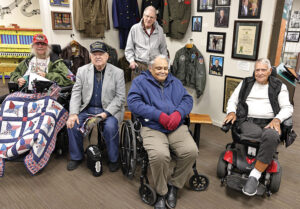
St. Clair’s secret military past
Story by Leigh Pritchett
Submitted photos courtesy of the
Scarboro Collection, John McFarland and
government archives
Etowah County spent much of World War II shooting at St. Clair County.
That is the lighthearted explanation that historian John McFarland of Rainbow City gives for the “friendly fire” relationship the two counties shared.
Nonetheless, his summary is factual: The woodlands of St. Clair and Etowah counties cloaked a military installation’s clandestine mission.
Called Camp Sibert, the reservation stretched 36,300 acres. Attalla and Gadsden served as the boundary on the Etowah County end of the camp. In St. Clair, Sibert extended into Steele and nearly to Ashville. The installation’s other two boundaries basically were U.S. 411 on one side and U.S. 11 on the other, said Wayne Findley, instructor at Gadsden State Community College and a historian who has spent 25 years researching the camp.
“It was huge, massive,” Findley said of Sibert.
And yes, Etowah did take aim at St. Clair, possibly millions of times.
That is because equipment was set up in the vicinity of Dunaway Mountain in Etowah County, very near to the border of St. Clair. During training sessions, mortar and bigger artillery were fired across Canoe Creek into St. Clair, explained Findley.
“The Chemical Warfare Service loved this place” because troops could use live rounds and chemicals, Findley remarked.
The mission of the camp was so stealth that soldiers were bound by an oath of secrecy, Findley said. They were not released from it until the 1990s, and those who lived around the camp apparently knew little of its mission.
“The people didn’t know a whole lot of what was going on in Camp Sibert,” only that some chemical weapons were involved, said 88-year-old Fred Rogers of Chandler Mountain in Steele. He was a teenager when the camp was established.
Yet, some facets of the camp were highly publicized and helped to promote the war effort. One piece of memorabilia in McFarland’s extensive Sibert collection is an October 1943 Senior Scholastic reader, whose cover photograph is of a smoke generator creating a smoke screen at the camp.
 Findley also noted that Sibert fielded a baseball team – the Gas House Gang – that won a state championship. Plus, the camp’s band was sent on tours as an encouragement to citizens to be proud of their military.
Findley also noted that Sibert fielded a baseball team – the Gas House Gang – that won a state championship. Plus, the camp’s band was sent on tours as an encouragement to citizens to be proud of their military.
The work to establish Camp Sibert commenced three months after the Japanese bombed Pearl Harbor on Dec. 7, 1941.
According to a chronology Findley has composed, the U.S. Army on March 13, 1942, inspected the site under consideration for Camp Sibert.
“Six days later, the area in northeastern Alabama was chosen over similar areas in West Virginia and Texas,” states an article written by Findley and fellow researcher Joseph T. Robertson (now deceased) for the January 1995 edition of The Alabama Review: A Quarterly Journal of Alabama History.
Fred Rogers noted that the expanse encompassed by the camp was known as the “flatwoods area” because it consisted of farmland and forestation, with few roads. “It was perfect for what they wanted to do with it,” Findley said.
According to The Review article, the site had to possess certain features needed for chemical warfare training: a secluded place where toxic gas could be used, basically level terrain for tanks and armored vehicles, and wetlands and forestation for bivouacs.
In June 1942 the government began issuing “Declarations of Taking” to obtain the necessary properties, the chronology states.
St. Clair County probate records available at Ashville Museum and Archives list owner after owner whose land the government was acquiring and the compensation each person was receiving. Some of the entities affected by the acquisition were Deerman’s Chapel Church and Deerman’s School, among others.
In all, 557 tracts of land in Etowah and St. Clair were involved in the acquisition, states The Review. “With the assistance of the Farm Security Administration, all 339 families who resided in the area were relocated with no major problems. Construction of the camp began immediately.”
Also in June 1942, a “tent city” formed to quarter those who would work on the camp before permanent accommodations were available, Findley’s chronology shows. The next month, the first trainees arrived.
On Christmas Day 1942, the camp was dedicated, “although it was only 80 percent complete. By the summer of 1943, the camp was self-sufficient” and could accommodate as many as 30,000 soldiers. With 41 miles of roads, the camp boasted 1,500 buildings, among them a hospital, theater and prison stockade, according to The Review.
Findley and McFarland said the camp also had an airport, store, chapel, lighted tennis courts, boxing ring and its own newspaper.
The scope of Camp Sibert was a premier undertaking. “Never before in the history of the Chemical Warfare Service had such an extensive facility been provided for instruction in the tactics and techniques of chemical warfare,” The Review states.
The “Post War Utilization Studies,” a War Department document dated September 1945, placed the total cost of construction and land acquisition at about $17.66 million.
The installation was named for Etowah native Maj. Gen. William Luther Sibert. During World War I, Sibert was handpicked by Gen. John Pershing to command the first U.S. soldiers into France in 1917, The Review reveals. “Because of his experiences, Sibert would be appointed the first Chief of the Chemical Warfare Services.”
At the time of World War II, some thoroughfares in Etowah and St. Clair were known by different names, Findley said. For example, the present-day U.S. 411 was “U.S. 11” then. What is now U.S. 11 was “Alternate 11.”
While the camp was in operation, names of some other roads were different too, stated McFarland. Pleasant Valley Road was “Range Road” and the site of Gate No. 2, while Canoe Creek Road bore the moniker “Impact Road.”
Findley added that the stretch from Attalla to Camp Sibert on what would later become Alabama 77 was called “Gate No. 1.”
The camp’s restriction on civilian traffic created a bit of a logistics problem for people in Steele who needed to go to other parts of St. Clair County.
“We couldn’t go through Camp Sibert to get to Ashville, the county seat,” Fred Rogers remembers. Residents in that part of St. Clair had to travel along “Alternate 11” to Whitney and on to what is now U.S. 231 in order to get to Ashville.
Though younger than his brother Fred, 85-year-old Hoover Rogers of Chandler Mountain also recalls a few things about the camp. One recollection is of seeing uniformed soldiers, with weapons in hands, coming over that mountain on training marches.
“I was intrigued by them and wondered where some of them were from,” said Hoover Rogers, who was a teen at that particular time in history.
He also remembers that word would get around when a celebrity, such as funnyman Red Skelton, was stationed at the camp.
Skelton was not the only famous person to be assigned to the camp. Heavyweight boxing champion Joe Louis, featherweight champion Bobby Ruffin and actor Mickey Rooney also trained there, Findley said.
In fact, Rooney met one of his many wives while stationed there, Findley said.
McFarland, who gives presentations at the University of Alabama-Gadsden Center, described the camp as “a catch-all.” In addition to chemical warfare instruction for entire units and for individuals who were to become replacements, the camp also provided basic training to recruits and housed prisoners of war.
Originally, its POW camp was a satellite of the one at Fort McClellan in neighboring Calhoun County. However, it soon became a separate entity, even incarcerating some of Adolph Hitler’s elite SS, or “storm troopers” as they were called, The Review reveals.
By mid-March of 1944, more than 12,000 soldiers and 88 combat units had received training at the camp, reported Findley.
In all, 169 US chemical warfare units were instructed there, a number that represented 47 percent of all such American units involved in World War II, The Review states. Of the 169 units, “44 were Black units.”
McFarland said Black soldiers generally were in smoke generator units or clerical positions, while Caucasian soldiers tended to be members of chemical mortar battalions.
In the spring and summer of 1945, the dynamics of World War II changed significantly, ultimately sealing the destiny of Camp Sibert.
With Germany surrendering first and Japan following a few months later, the need for the camp’s services greatly diminished.
In September of that year, the War Department issued its “Post War Utilization Studies,” on whether to make Sibert a permanent camp capable of accommodating 19,950 enlisted men, plus officers. Such an endeavor was estimated at $45 million. For this and other reasons, the project was deemed unfeasible.
As a result, the camp was decommissioned; the fixtures and contents were rendered to surplus; properties were sold to the original owners or to interested parties; and land, buildings and infrastructures were given to municipalities.
The Rogers brothers experienced some of the results.
After the war, Fred Rogers worked at AAA Pottery in Attalla, a business that was housed in old Army buildings. He later taught and was principal in a school situated on former camp property.
Hoover Rogers was a teacher and later principal of Chandler Mountain School, which benefited from surplus goods from the camp.
Their older brother, Henry (now deceased), purchased some Steele property that had been part of the camp and built his house there. Henry also worked as a civilian on “fire watch” (patrol duty) at the decommissioned camp until it was completely closed. When all surplus items were relocated and warehoused in Etowah County’s Glencoe, his job moved there, too, according to his brothers.
As a teen, Findley attended junior high in what had been the officers’ club. In the lunchroom, the autographs of Red Skelton and Mickey Rooney were still prominent. Findley also climbed chimneys that had been part of the camp hospital and collected brass he found near the rifle range.
McFarland, who lives in Etowah County close to the St. Clair border, resides on property that was within the cantonment of Camp Sibert. A few years ago, he received notification that his property qualified for a government cleanup effort.
Some 40 years after World War II, Congress determined that former defense sites should be cleaned up, according to Lisa Parker, deputy public affairs officer for the Mobile District of the Army Corps of Engineers.
It was the intent of Congress “to restore properties formerly owned by, leased to, or otherwise possessed by the U.S. and under the jurisdiction of the Secretary of Defense,” Parker stated.
Of the St. Clair sites that were investigated for possible cleanup, only one was found to need attention, noted the Corps of Engineers. Work at that site — which includes an area in Steele, close to Interstate 59 — is in progress.
Among the items already discovered are “4.2 mortars, .30-caliber rifle, machine gun, .22-caliber rifle, sub-machine gun, .45-caliber pistol, grenade, artillery, bazookas and anti-aircrafts,” said Parker.
Editor’s Note: Additional assistance with this article was provided by Charlene Simpson of Ashville Museum and Archives, RoseMary Hyatt of Northeast Alabama Genealogical Society, Pat Coffee of the Town of Steele, Jody Gilliland of Chandler Mountain Baptist Church and Jack Hayes of American Legion Post 109, Pell City.



















